Wow. This past week has been a very hectic one here at StockCharts.com. Four - count 'em - four H-U-G-E changes have happened in addition to our 10-year Anniversary Sale is drawing to a close. I posted about most of this stuff in my blog, but I wanted to review it again here to make sure everyone was aware of what's been happening.
Last Chance for our 10th Anniversary Special Pricing!
All through the month of April we've been running a special to celebrate our 10th year of providing great Internet financial charts. Right now, if you subscribe (or renew) for a year, you'll get 2 free months of additional service. If you subscribe for 6 months, you'll get 1 free month of additional service.
If you are already a member but your account doesn't expire for several more months you can still take advantage of this offer! Just place a renewal order now and we'll simply add the additional time on to the end of your account. You'll never see a better pricing deal from us so renew now and save.
US Stock Data Now Coming from IDC/Comstock
After numerous issues with our old datafeed, we've hit a major milestone in our efforts to improve the reliability and accuracy of our website. Data for all US stocks now comes from our new IDC/Comstock datafeed. This should greatly enhance the stability of our website. We are working to get Indexes and Canadian date from the new feed also but that will take some time.
This is a perfect example of a change that take us a ton of work and effort but doesn't result in something that's very visible to you. There's also no guarantee that the new feed will work better than the old one - although we fully expect that it will. Hopefully you understand that there is a TON of behind-the-scenes work like this that we do to ensure that the charts continue to flow.
New Support Area Debuts
Our new Support area is now live on the site and standing by to help you whenever you need it. You'll find improved articles, documentation and FAQs in our searchable KnowledgeBase as well as a new form for sending us your questions. The tools we use to answer your questions have also improved. Hopefully, you'll never need them, but it's nice to know they are there if/when you do.
To see the changes or send us a question, just click on the "Support" tab at the top of any page.
ChartSchool Gets a Design Facelift, Rest of the Site Will Get One Soon
It started with the Blog area, then it spread to the Market Message. Now it has spread to the Support area and ChartSchool. Will it ever be stopped?!?!?!?
I'm talking about the new design we have - cleaner with our new logo and simplified navigation links. Click on the "ChartSchool" tab to see it.
And the answer is "No - It won't stop. Soon it will take over the entire site." Unfortunately, it will take us some time to get everything converted so please be patient. For awhile, the site will have a "Split Personaility" as some pages have the old design and some have the new. Hopefully, it won't last too long. Look for the Home page and the Free Charts area to change soon.
Arthur Hill Officially Joins the StockCharts.com Staff as Senior Technical Analyst
After years of contributing content and commentary independently to StockCharts.com, Arthur Hill has decided to join us on a full-time basis. In addition to contributing insightful commentary in our Market Message area, Arthur will contribute to our free blogs and our ChartSchool area. We also hope to start posting more of Arthur's videos on the site soon. Welcome aboard Arthur!
Phew. That's enough for one week don't 'cha think?
The McClellan Oscillator is a short- to intermediate-term momentum
breadth indicator. It's calculated each day by taking the difference
between the 39-day and 19-day exponential moving averages of the number
of net advances on the NYSE (see Chart School for a more in-depth
explanation). The chart below shows the NYMO (black line) compared to the NYSE
Composite Index (green line). The McClellan Oscillator fluctuates
between an oversold level below -100 and overbought territory above
100. Short-term buy and sell signals are given when it crosses above or
below its zero (flat) line. The chart shows, for example, the NYMO
bouncing from oversold territory in late February before crossing over
its zero line in early March (circle). Although it has backed off from
overbought territory at 100, it remains above its zero line. It would
have to fall below that line to signal an end to the rally. The
McClellan Oscillator is only useful over the short to intermediate
term. In my view, its greater value lies in its longer-range version
which is called the Summation Index.
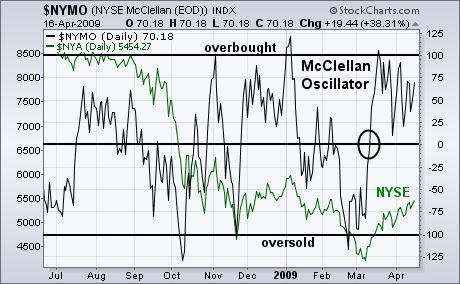
DIA MAINTAINS UPTRENDby Arthur Hill | Art's Charts The Dow Industrials ETF (DIA) shows a classic case of
becoming overbought and remaining overbought. I featured DIA in ChartWatchers
two weeks ago as it hit potential resistance around 80. The song remains the
same as DIA finished at 81.31 on Friday.
Let's
review resistance. First, the middle of the prior consolidation (yellow area)
marks resistance in the lows 80s. Second, the Mar-Apr advance retraced around 62%
of the Jan-Mar decline. In addition to resistance, the Commodity Channel Index
(CCI) moved above 100 (overbought) for the fourth time in the last four weeks. Even
though overbought conditions and resistance argue for a pullback, DIA refuses
to cooperate with the bears right now.
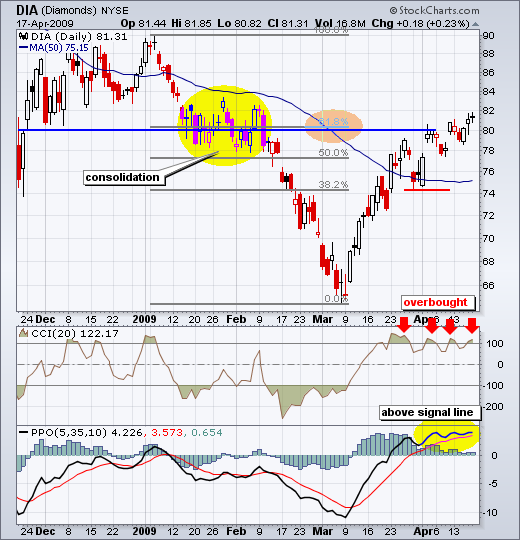
This calls for another indicator that is more sensitive to
the actual trend, which is clearly up. Enter the Percentage Price Oscillator
(PPO). As the difference between two moving averages, the Percentage Price
Oscillator (PPO) is a rare breed that offers the best of both worlds: a little trend
and a little momentum. Moving averages measure trend, while oscillators measure
momentum.
The
bottom window shows the Percentage Price Oscillator (5,35,10) with its 10-day
EMA (red signal line). Even though the indicator flatted over the last three
weeks, it never broke below its signal line. The histogram shows the difference
between the indicator and the signal line. While upside momentum may be waning,
DIA is still edging higher and I will be watching the Percentage Price
Oscillator (PPO) for break below its signal line that could signal the start of
a correction. Expect DIA to continue higher as long as the Percentage Price
Oscillator holds above its signal line.
The bear market rally has continued to move prices higher, and the
strength is greatest in the smaller-cap stocks. For example, the
S&P 500 has rallied 30% from the March lows, but the Rydex S&P
Equal Weight ETF (RSP) has advanced 45%. Looking through the list of
the Spider Sectors and their equal weighted counterparts, we can see
that the equal weighted indexes are doing much better than the
traditional cap-weighted indexes. Nevertheless, the S&P 500 has
managed to move above the medium-term resistance presented by the
declining tops line of the recent trading channel.

As we have noted in recent articles, prices have been advancing in the
face of overbought short-term indicators. See the CVI below. It has
stayed mostly on the overbought side of the zero line, and prices have
moved higher as th CVI has diverged negatively. This is bullish and is
evidence that the rally is probably not over; however, medium-term
indicators are now becoming overbought. Note that the S&P 500 PMO
(above) is above 2.5, and the VTO below are very overbought.
On the chart below we can see that our intermediate-term breadth and
volume indicators are very overbought by historical standards. In a
bear market this can be a problem; however, a bear market rally is like
a mini-bull market, so it is possible for overbought conditions to
clear without much (or even any) price deterioration.
Bottom Line: Based upon my perception of market behavior versus
indicator status, I am expecting some kind of correction, possibly a
short consolidation -- a week or so -- or a quick, scary couple of down
days. Regardless of how the overbought conditions are cleared, I am
assuming that the rally is not over and will persist for at least a few
more weeks.
In my last article, I noted that I was "undeniably bullish". I can tell you that nothing occurred these last two weeks to change my mind. More and more corroborating technicals have lined up to suggest this current rally has legs. Perhaps the most important of them all was the triangle breakdown on the VIX. The first chart below highlights the triangle that developed on the VIX during the 2000-2002 bear market and the subsequent breakdown of that triangle and how the S&P 500 surged higher following the breakdown:
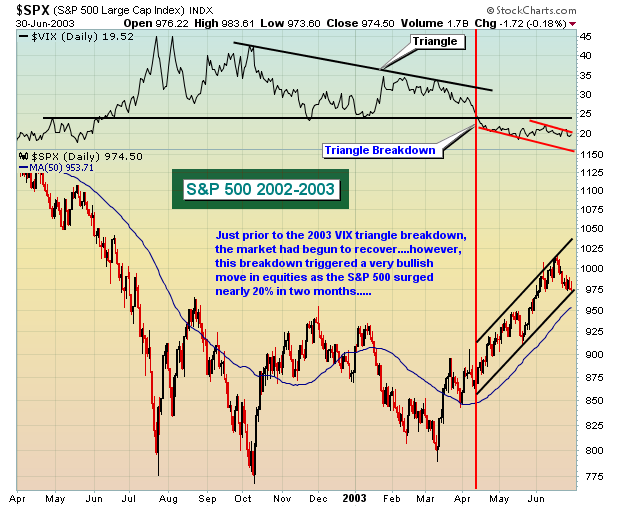
From the moment the VIX broke down, the major indices began rallying. And the rally lasted for quite some time, with few pullbacks along the way. Last week, the VIX broke below triangle support at 38 or so, then broke down below long-term price support at 36. The question now becomes - will the major indices rally off of this breakdown as they did in 2003? I believe they will. Take a look below at the setup of the market as the VIX breaks down from a triangle pattern once again:
The sectors that need to lead the market higher out of bear market territory are doing so. Financials, technology (semiconductors in particular), transportation, consumer discretionary - these are the groups we want to see moving higher. Check out the relative strength in financials:
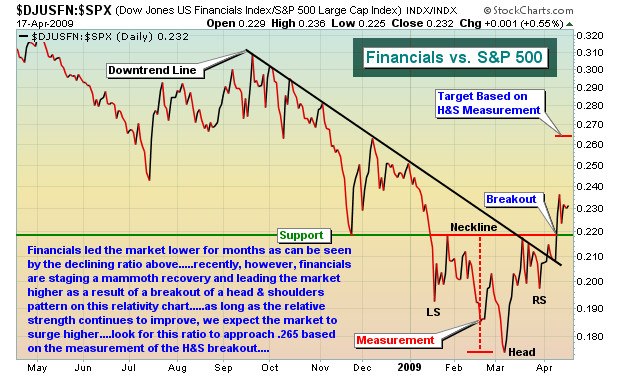
It's important to recognize that market conditions have changed. That suggests you should change your trading strategies as well. Let me give you an example of how we've operated. From October 1st through March 22nd, we alerted only 10 individual stocks, instead shifting to more conservative and less volatile ETFs. During the same period, we alerted 24 ETFs. We were in capital preservation mode, only risking capital when it seemed appropriate. Over the last three weeks, we have alerted 25 individual stocks and 0 ETFs. It's not that we don't like ETFs, we simply believe trading ETFs lowers returns in an environment where individual stocks are thriving on the long side. Trade the best stocks within the best sectors, timing entry and exit points based on technical support and resistance levels. Many technical indicators were useless for several months while emotional trading ran wild. That has changed and technicals are now back in style and much more reliable. To see the stocks we've traded, click here.
I would like to encourage those of you who trade "juiced" sector and index ETF's (eg, SKF, UYG, SRS, URE, etc) to review an earlier video presentation that details many of the common pitfalls of the juiced ETF trader. Two items should be kept in mind at all times. First, these juiced ETFs are designed to do their jobs for ONE DAY only. They lose value over time similar to options (though not to the same degree). Secondly, determine entry and exit points on the juiced ETFs based on your technical analysis of the underlying index. Too many traders look at the charts of the juiced ETFs themselves, searching for key support and resistance levels, or trading them on 20 day EMA tests or 50 day SMA tests. That approach will not work with any consistency because of what's been mentioned above. To view this presentation, click here.
Happy trading!
LUCKY #7by Richard Rhodes | The Rhodes Report The various US market averages have seen six straight weeks of rally, and one must wonder is "lucky #7" is in the offing. We don't know honestly; however, there are signs the rally off the March 9th low is becoming "long in the tooth" and primed for a rather "nasty correction"in our minds. To this end, we think it instructive to look at the weekly CBOE Volatility Index or VIX.
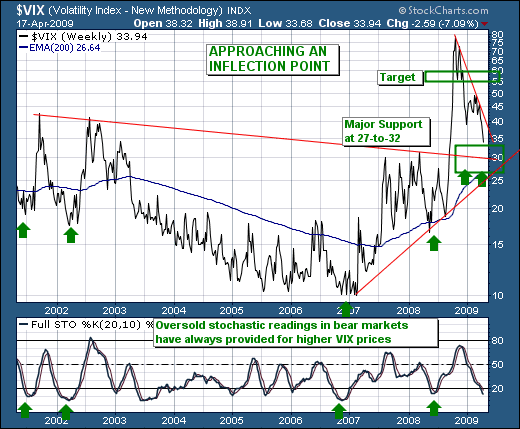
Our interest here is upon the recent decline from rough panic-level of 80 to its current complacent-level of 34. Quite a bit of marginally good or second derivative news as we could say has pushed it lower; however, we would caution as it is on the verge of forging a bottom that should result in a sharp upward move that would coincide with a larger downward movement in the US market averages. The decline has reached back into trendline support levels, and has done so with the 20-week full stochastic moving back into oversold territory. This latter point is most critical: during bear markets, an oversold stochastic reading such as this has led to sharp upward adjustments. If we had to venture, then we would put the retracement higher at 50% of the downward move, which would roughly target the 55-60 zone.
If this forecast were to come to fruition; then we would likely see the major averages "test" their March lows. Thus, we foresee quite a bit of downside remaining in the equity markets; although there are interim hurdles that must be broken before this will occur. If they hold, then certainly higher prices could materialize in a larger mean reversion exercise; although that isn't our preferred forecast yet.
--
Good luck and good trading,
Richard